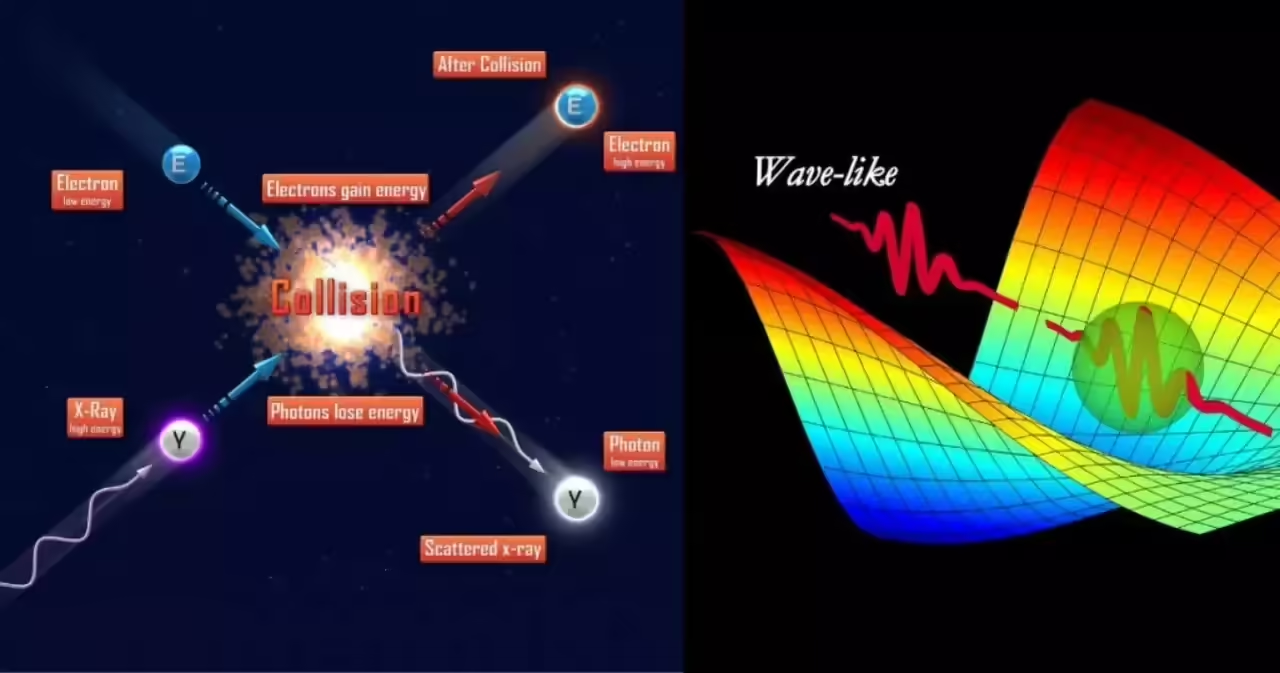
Introduction to the Compton Effect: The Compton Effect is a fundamental phenomenon in physics that reveals the wave-particle duality of light and provides compelling evidence for the quantum nature of subatomic particles. Discovered by the American physicist Arthur H. Compton in 1923, this effect challenged conventional ideas about light and marked a significant milestone in the development of quantum theory.
Brief Description of the Phenomenon: The Compton Effect describes the change in the wavelength of photons when they interact with charged particles, such as electrons. In simpler terms, when light impinges on a surface, some of its photons scatter energy upon colliding with subatomic particles. This phenomenon causes the scattered light to have a different wavelength than the incident light, indicating the quantum nature of light.
Historical Context of the Discovery: The discovery of the Compton Effect occurred during a crucial period in physics when quantum theory was emerging as a revolution in our understanding of the subatomic world. In the early 20th century, the theory of light as an electromagnetic wave was well-established, but phenomena like blackbody radiation and the photoelectric effect challenged this description.
Arthur H. Compton, in an effort to understand X-ray scattering, conducted experiments demonstrating that photons were not only energy particles but also exhibited properties of material particles. By analyzing the change in the wavelength of scattered photons, Compton provided empirical evidence supporting the wave-particle duality theory of light proposed by Albert Einstein and Max Planck.
This discovery not only contributed to the understanding of light but also laid the groundwork for the development of quantum mechanics, a theory that would revolutionize physics by explaining the behavior of subatomic particles more accurately.
Physics Behind the Compton Effect: Exploring Wave-Particle Duality and Quantum Photon Dispersion Detailed Explanation of the Physical Process:
Photons and Wave-Particle Duality: Light behaves as both a wave and a particle, according to quantum theory. Each light particle, or photon, has an associated energy that is inversely related to its wavelength.
Interaction with Electrons: When a beam of light, composed of photons, strikes a material containing electrons, some photons interact with the electrons on the material’s surface.
Collision and Energy Transfer: During the interaction, some photons collide with the electrons and transfer part of their energy to the electrons. This process can be better understood using the particle model of photons and electrons.
Inelastic Scattering: The resulting scattering is inelastic, meaning that the total energy is not fully conserved. The transfer of energy causes a change in both the direction and speed of both photons and electrons.
Change in Wavelength: One of the most significant outcomes of the Compton Effect is the change in the wavelength of scattered photons. The magnitude of this change is directly related to the scattering angle and can be calculated using the principles of energy and momentum conservation.
Evidence of Quantum Nature: The key to the Compton Effect is that the change in wavelength cannot be explained by the classical theory of light as an electromagnetic wave. Only through the quantum approach, considering photons as particles, a coherent explanation of the observed phenomenon is achieved.
Relation to Photon Dispersion: Photon dispersion in the Compton Effect refers to the change in the direction and energy of photons after interacting with charged particles, in this case, electrons. This dispersion is the result of the collision between photons and electrons, where part of the photon’s energy is transferred to the electron.
The angular dispersion of scattered photons is directly related to the amount of energy transferred during the collision. The change in the wavelength of scattered photons, known as Compton shift, is explained by the conservation of momentum and energy, fundamental principles of quantum mechanics.
Medical Applications of the Compton Effect: Exploring its Uses in Diagnosis and Therapy
The Compton Effect, discovered in the realm of quantum physics, finds valuable applications in the field of medicine, both in diagnosis and therapy. Below are some of the most relevant uses of the Compton Effect in the medical field, along with their advantages and disadvantages.
Use of the Compton Effect in Medicine:
Computed Tomography (CT): CT utilizes the Compton Effect to obtain detailed images of the interior of the body. X-rays, when incident on body tissues, undergo Compton scattering, allowing the creation of high-resolution three-dimensional images. This technique is crucial in detecting and diagnosing various medical conditions.
Magnetic Resonance Imaging (MRI): Although MRI is not directly related to the Compton Effect, the combination of techniques allows for more comprehensive and accurate images. Information from Compton scattering in CT complements the information provided by MRI, enabling a more thorough assessment of internal structures.
Radiation Therapy: In cancer treatment, radiation therapy harnesses the Compton Effect to direct high-energy radiation towards cancer cells. The photon scattering generated by the Compton Effect allows concentrating radiation on specific areas of the tumor, minimizing damage to surrounding tissues.
Advantages of its Application:
Detailed Images: In CT, Compton scattering provides detailed images of soft tissues and internal organs, allowing for more precise diagnosis.
Precision in Treatment: In radiation therapy, the ability to precisely direct radiation thanks to the Compton Effect reduces the risk of damage to healthy tissues near the tumor.
Early Diagnosis: The CT’s ability to detect anomalies in their early stages is crucial for the early diagnosis of diseases.
Disadvantages of its Application:
Exposure to Radiation: In techniques like CT, radiation exposure is a concern, especially in repeated studies. Risks and benefits must be carefully considered.
Costs and Specialized Equipment: The implementation of specialized radiation therapy and CT equipment can be expensive, limiting availability in certain medical settings.
Limitations in Temporal Resolution: While CT offers detailed images, its ability to capture events in real-time is limited. In some cases, other techniques like dynamic magnetic resonance may be more suitable.
Radiation Therapy and Cancer Treatment: The Crucial Contribution of the Compton Effect in Selective Destruction of Cancer Cells
Radiation therapy is an essential tool in cancer treatment, and the Compton Effect plays a crucial role in the selective destruction of cancer cells. This therapeutic approach relies on the ability of ionizing radiation, generated through the Compton Effect, to damage the DNA of cells and hinder their ability to divide. Here, we explore applications in oncologic treatments and how the Compton Effect becomes a fundamental ally in this fight against cancer.
Applications in Oncologic Treatments:
External Beam Radiation Therapy: In external beam radiation therapy, a radiation beam is directed from outside the body towards the tumor region. The Compton Effect is crucial here, as high-energy photons generated by the effect penetrate the tissue and, interacting with electrons in cancer cells, cause damage to the DNA. This leads to the inhibition of cell division and ultimately the destruction of malignant cells.
Internal Radiation Therapy (Brachytherapy): In brachytherapy, radioactive sources are placed inside or near the tumor. The Compton Effect also plays a significant role here, as photons emitted by the radioactive sources interact with the electrons of cancer cells, causing direct damage to the DNA and achieving selective destruction of malignant tissue.
Proton Therapy: Protons, positively charged particles, are also used in radiation therapy. Although not directly related to the Compton Effect, their application leverages the ability of these particles to deposit energy more selectively in the tumor, reducing the dose to surrounding tissues.
How the Compton Effect is Crucial in Selective Destruction:
Interaction with Electrons: The Compton Effect is especially effective in radiation therapy because high-energy photons interact significantly with the electrons of cancer cells. This interaction causes Compton scattering, generating secondary electrons and scattered photons.
Energy Transfer: The energy transfer during Compton scattering is sufficient to ionize atoms and break chemical bonds in the DNA of cancer cells. This damage prevents cell replication and leads to programmed cell death (apoptosis) or the cell’s inability to divide.
Greater Selectivity: Since cancer cells often have higher rates of cell division than normal cells, they are more susceptible to radiation. The ability of the Compton Effect to selectively damage DNA in actively dividing cells contributes to the specificity of the treatment.
Optimization of Dosage: The ability to control the dose and direction of radiation beams generated by the Compton Effect allows oncologists to optimize therapy, maximizing tumor destruction while minimizing damage to healthy tissues.
Radiation and Safety: Considerations and Measures in Medical Applications
The use of radiation in medical applications, such as radiation therapy and computed tomography (CT), is an invaluable tool for the diagnosis and treatment of diseases but also involves crucial considerations in terms of radiation exposure. Here, we explore the main considerations and safety measures and precautions applied in medical environments.
Considerations on Radiation Exposure:
Cumulative Dose: The total amount of radiation absorbed by an individual over time, known as cumulative dose, is a critical concern. It is important to limit this dose to avoid possible long-term adverse effects, such as an increased risk of cancer.
Differentiation between Ionizing and Non-Ionizing Radiation: The radiation used in medical applications is usually ionizing, meaning it can ionize atoms and molecules in biological tissues. This capability can have health consequences, so specific precautions are required.
Tissue Sensitivity: Some body tissues are more sensitive to radiation than others. For example, tissues like nerve tissue and developing tissue are more susceptible to the harmful effects of radiation.
Occupational and Patient Exposure: Medical staff operating radiation equipment must be aware of occupational exposure. Similarly, patients undergoing radiological procedures should receive minimal doses necessary to ensure effective diagnostic or therapeutic results.
Safety Measures and Precautions in Medical Applications:
Shielding and Distance: The use of lead barriers or similar materials and maximizing the distance between the radiation source and medical staff helps reduce radiation exposure. These measures are common in radiation therapy rooms and X-ray areas.
Personal Dosimetry: Personnel exposed to radiation carry personal dosimeters that record the amount of radiation received. This allows tracking cumulative exposure and ensuring compliance with established safety limits.
Advanced Imaging Techniques: Optimizing imaging techniques, such as dose reduction in CT and the use of magnetic resonance imaging when possible, contributes to minimizing radiation exposure, especially in children and pregnant women.
Education and Training: Training medical staff on safe practices and proper use of equipment is essential. This includes awareness of the risks associated with radiation and the importance of following safety protocols.
Justification and Optimization: Justification and optimization are key principles in the use of radiation in medicine. Each exposure to radiation must be justified, ensuring that the benefits outweigh the risks. Additionally, doses should be optimized to achieve effective results with the least possible exposure.
Management of Radioactive Waste: The proper disposal of radioactive waste is an integral part of safety in the medical application of radiation. Materials used must be handled and disposed of in accordance with environmental regulations and standards.







